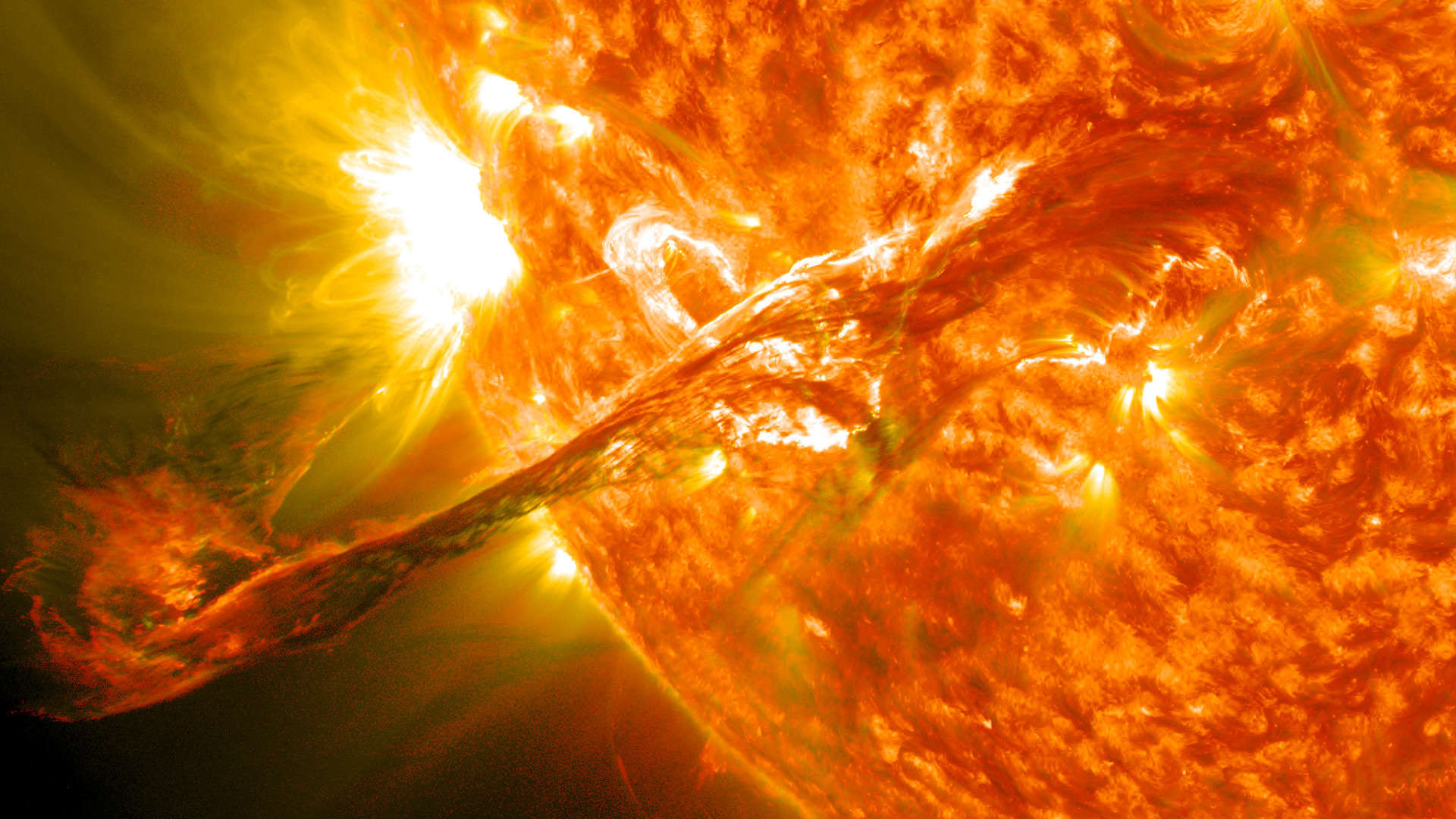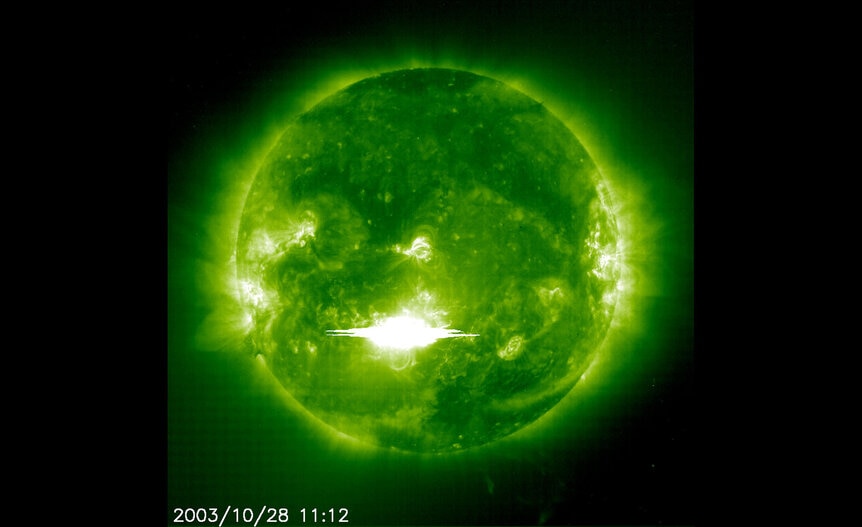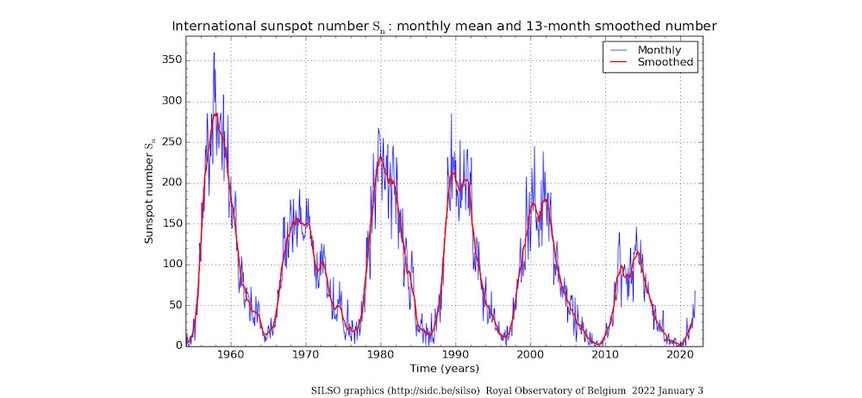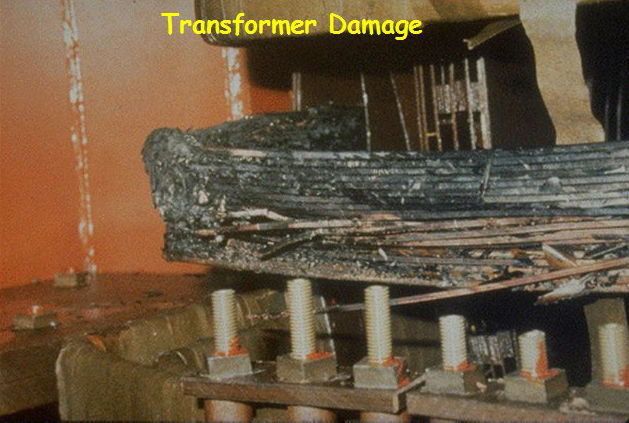Create a free profile to get unlimited access to exclusive videos, sweepstakes, and more!
In 7176 BCE, the Sun erupted in what may be the biggest blast in 10,000 years
Immense solar storm occurred over 9,000 years ago that would be devastating today.

The Universe is scary. There are dangers galore, including black holes, asteroid impacts, supernova explosions, and more. However these events tend to be far away and/or extremely rare, so they're nothing you really need to worry about in your daily life.
And then there are solar storms. If there's any astronomical event we need to take very, very seriously, even more than asteroid and comet impacts, it's these.
We know of several big ones that have happened in the past century or two, but historic storms can be discovered as well. Looking at ice cores from Greenland and Antarctica, scientists just announced they found a new one. It occurred in 7176 BCE, and it was huge, possibly the largest in the past 10,000 years (link to paper).
Solar storms come in two broad categories. One type is a solar flare, an immensely powerful explosion on the Sun's surface that is extremely bright in high-energy gamma and X-rays. Another is a coronal mass ejection, or CME, which is when a huge area above the Sun blasts up to a billion tons of subatomic particles away at speeds of millions of kilometers per hour. Both are generated by the Sun's magnetic field, which can store tremendous energy, and sometimes a flare is followed by a CME.
Both can wreak havoc on Earth. A truly big eruption from the Sun aimed our way would be disastrous for our modern civilization. It could wipe out satellites, cause electronics damage on the ground, and also create widespread power outages by taking down the electric power grid. A severe storm could leave large swaths of humanity without power for a long time, months or more. It would be catastrophic.
We've seen a handful of storms this big in modern times. In 1989 a solar event blew out transformers in Canada, causing a power outage in Quebec. Another in 1859, called the Carrington Event, ushered in the modern era of studying solar storms. There was one in 1956 so powerful it's now used as a baseline for measuring the effects of storms on Earth. A truly massive CME erupted from the Sun in 2012, but missed the Earth. It is no exaggeration to say that had it been aimed right at us it could have been the biggest catastrophe of the modern age.
We can also trace historic solar storms from before the modern era. The protons streaming in from a CME hit our upper atmosphere and bombard the atoms there. Nitrogen and oxygen nuclei split, creating a radioactive isotope of beryllium called beryllium-10, which then falls with rain to Earth's surface. A similar effect happens when the protons hit argon in Earth's air, creating radioactive chlorine-36, and carbon-14 is created in a similar fashion from nitrogen.
All three of these isotopes are overwhelmingly created by extraterrestrial protons hitting our air. Sometimes this is from galactic cosmic rays, subatomic particles zipping around space at high speeds, accelerated by supernovae. But the Sun is the other main source.
Tree rings can be used to look for spikes of carbon-14, and get the dates of those events. Another way is to look in ice cores, which can be used to reliably date events like this back thousands of years. Spikes in beryllium-10 have been seen in cores from 774 and 993/4 CE and another in 660 BCE, indicating big events. In fact, the 774 event was so big at first scientists didn't think the Sun was capable of creating such a powerful storm, but later studies showed that it could.
The new work looked at ice cores from several spots in Greenland and one in Antarctica. The annual levels of beryllium-10, chlorine-36, and carbon-14 were measured, and all show a pretty large spike in amounts 9198 years ago: 7176 BCE. Be-10 was enhanced by a factor of about 3-4 over its usual amount, C-14 by 4.5 times, and Cl-36 a staggering six times.
Clearly, this was an enormous event and I'm rather glad it happened long before the computer age. And as much as it makes my skin crawl to think about such things, the scientists determined something else about this 7176 BCE event that made the hairs on the back of neck stick straight up: The evidence indicates this happened at a solar magnetic minimum.
For reasons still not totally understood, the Sun's magnetic activity occurs on a roughly 11-year cycle, going from being weak to peaking in strength about 5.5 years later, then weakening again. Activity like sunspots, flares, and CMEs tend to happen near or just after a cycle's peak. Sometimes they happen at a solar minimum, but that's pretty rare.
When the Sun's activity is strong it protects us from galactic cosmic rays, acting like a force field, and when it's weak those particles can make it to Earth. When they do they create Be-10, so the scientists looked at the cycle of Be-10 in their ice cores. What they found is that the huge spike happened when Be-10 production was at a peak, meaning cosmic rays were getting to Earth, in turn meaning the Sun was at a magnetic minimum*.
So, um, yikes. How could the Sun produce such a massive storm when its activity was dialed down? It's not clear. It turns out earlier work hinted at the 774 CE event also occurred at a solar minimum, and ice core measurements in this new research support that conclusion. So unless these measurements are severely in error, the Sun can have epic eruptions even when it seems quiet.
I won't lie to you, that's disturbing. It's bad enough that the Sun can get pretty feisty at solar maximum, but if this result holds up and it can have blowouts at minimum, then solar astronomers will need to figure that out.
And not just because it's an interesting academic problem. This has real-world effects, and is something I've been hammering for years. Decades. In the United States, the electric power grid was built in the 1950s when the population was much lower and energy needs commensurately lower, too. Nowadays the electricity running through the grid is much closer to capacity, making it far easier to overload it.
A big magnetic pulse from the Sun can couple with Earth's magnetic field, creating what's called a geomagnetically induced current underground, which in turn can cause a surge of power to run through the lines, overloading them. That could cause widespread damage to the grid, including destroying transformers that are ridiculously difficult to replace. A bad storm could take years to recover from. Hospitals, stores, businesses in general, and of course homes could be massively affected by such an outage.
And that is why I am so concerned about the Sun. It's the source of light and heat that are necessary for life on our planet to exist, but that doesn't mean it's always benevolent. Big solar storms like the ones in 7176 BCE, 774 CE, and more recently must be taken seriously. The good news is that we're learning much more about them thanks to NASA, NOAA, ESA, and other government agencies that build satellites to watch the Sun and fund astronomers to study that data.
We need to understand the Sun. Solar science is critical to our technological civilization, and I mean that in the most literal way I can.
*It's possible this event was actually something from outside our solar system, like a magnetar flare, kilonova, or something else. In most cases the expanding debris from such an event would still be visible, but to be fair I don't think we can completely exclude something like that. Caveat lector.






























